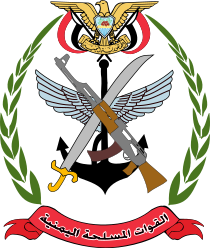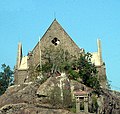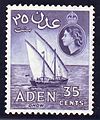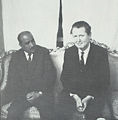Portal:Yemen
Yemen Portal


Owing to its geographic location, Yemen has been at the crossroads of many civilisations for over 7,000 years. In 1200 BCE, the
Since 2011, Yemen has been enduring
Selected article -
The
List of selected articles
|
|---|
|
Selected biography -
List of selected biographies
|
|---|
General images -
-
Balhaf/Burum coastal area, UNESCO Tentative Site (from Tourism in Yemen)
-
Zaidi State under the rule of Al-Mutawakkil Isma'il (1675) (from History of Yemen)
-
Ruins of The Great Dam of Marib (from History of Yemen)
-
Imam)Sana'a(from History of Yemen
-
Current (November 2021) political and military control in ongoing)Islamic State of Iraq and the LevantControlled by Southern Transitional Council(from History of Yemen
Selected city -

Selected picture -
-
A bronze statue of Dhamar Ali Yahbur II, a Himyarite Kingdom king who probably reigned in late 3rd or early 4th century AD. Displayed in the Sana'a National Museum.
-
dragon's blood tree (Dracaena cinnabari) in Socotra
-
Seiyun Palace was the royal residence of the sultan of Kathiri, located in the town of Seiyun in the Hadhramaut region, Yemen. It is one of the world’s largest mud-brick structures.
-
A Yemeni Jambiya
-
Al Saleh Mosque in Sana'a.
-
Temple of Awwam in Marib.
-
Bronze lion with a rider made byQatabaniansthe circa 75-50 BCE.
-
Jews of Maswar, Yemen, in 1902
-
A Griffon from the royal palace at Shabwa, the capital city of Hadhramaut
-
Barran Temple in Marib.
-
Ruins of the Great Marib Dam (1988)
Selected cuisines, dishes and foods -
List of articles
|
|---|
Related portals
Religions in Yemen
Arab states
Categories
Topics
Related portals
Religions in Yemen
Arab states
Associated Wikimedia
The following Wikimedia Foundation sister projects provide more on this subject:
-
Commons
Free media repository -
Wikibooks
Free textbooks and manuals -
Wikidata
Free knowledge base -
Wikinews
Free-content news -
Wikiquote
Collection of quotations -
Wikisource
Free-content library -
Wikiversity
Free learning tools -
Wiktionary
Dictionary and thesaurus









































































